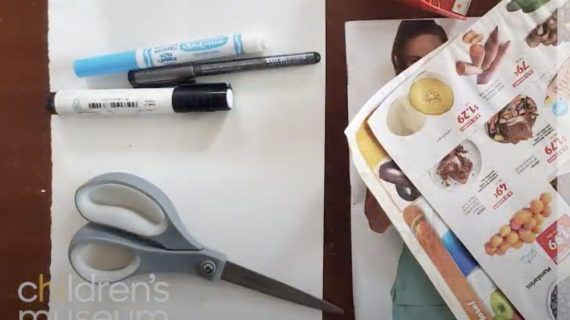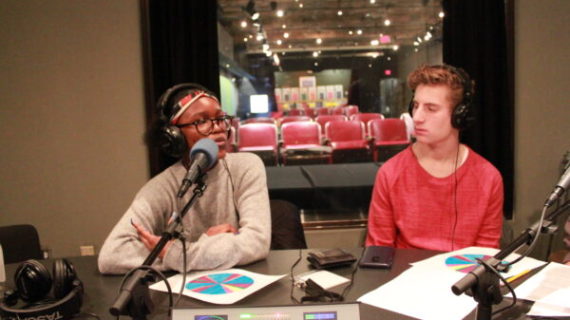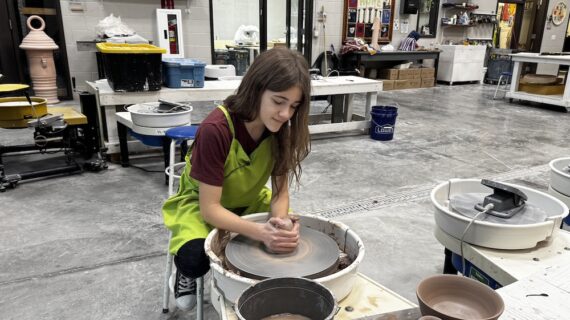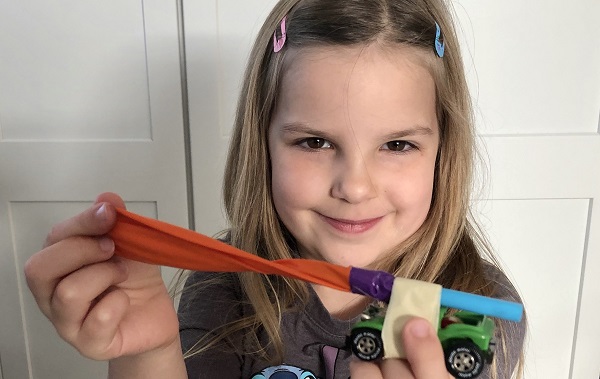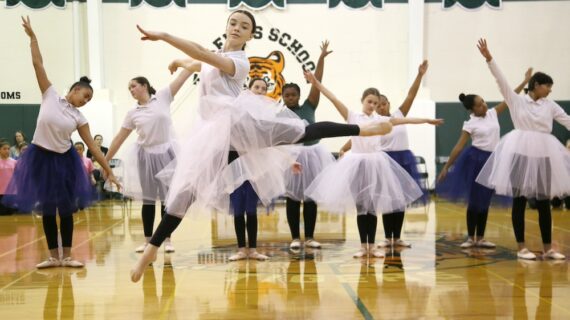
Active reading: A tutoring program uses movement, balls, sandboxes and more to bridge the literacy gap
In photo above, Cindy Kerr encourages Journey Washington, 6, for sounding out a word. All photos by Anastasia Busby/PublicSource.
Twice a week, 6-year-old Journey Washington meets her tutor Cindy Kerr at New Church School in Point Breeze.
On a Wednesday evening in January, Kerr taught Journey how to spell and identify unvoiced and voiced ‘th’ words. But instead of reading and repeating words from a textbook, Kerr started the lesson by playing Journey’s favorite ‘cheer’ game.
“Let’s say ‘bath,’” Kerr said and threw a ball at Journey.

Kerr is a tutor with a reading intervention initiative of the Learning Disabilities Association of Pennsylvania [LDA] that aims to provide free tutoring for underserved kids, including those from low-income families.
As she caught the ball, Journey cheered, “Woohoo, bath is ‘b-a-th,’” sounding out the phonemes. Next, she spelled out the word in a sandbox and wrote it on a chalkboard.
Journey later read words like path, this and them out loud to her three stuffed animals and spelled them while riding her exercise bike.
“We involve a lot of movement in the class to help kids learn better,” said Kerr.
Founded just before the pandemic, the nonprofit LDA’s reading intervention is divided into two programs:
- Early literacy tutoring, which offers group tutoring to kids who need help reading between kindergarten and second grade
- And one-on-one reading intervention for students of any age.

Fourth graders in Pennsylvania, who were kindergartners at the onset of COVID-19, scored lower in reading and math than fourth graders in 2019. Students in Pennsylvania scored slightly above the national average but low-performing students are falling further behind.
In Pittsburgh Public Schools, the city’s largest school district, third-grade reading proficiency was 46.2%, down 1.6% from last year, according to WESA. Racial disparities continue to persist — white students’ scores increased by nearly three percentage points in 2023, while scores among Black students, English language learners and students with disabilities declined by roughly the same amount.
“The struggles that I had as a parent to get my child and my husband to learn how to read, made me go, ‘Why? Why is it so difficult to have this service and it’s so expensive for the kids that need it?’” said LDA Vice President Carrie Gardner, whose husband has dyslexia.

Using eyes, ears and hands to read
Taylor Erickson typically begins her class at the Carnegie Library of Pittsburgh’s Hill District branch by sky-writing: Her students stand up, wiggle their bodies to prepare for movement and use their arms like pencils to trace out letters.
She uses this technique among small groups in her twice-weekly classes to teach trick words — words that don’t sound the way they are spelled.
“This really helps to get things into memory for kids because it is involving their movement and their vision,” she said.
LDA’s two reading programs are based on the Orton-Gillingham methodology which is aimed at students with dyslexia. This literacy method uses a multi-sensory approach which involves visual, auditory and kinesthetic senses to aid reading.
The program tutored about 85 students last year and is based out of four locations targeting underserved communities — The Hill District’s library, Pittsburgh Miller Elementary, Bedford Dwellings and Pittsburgh Woolslair Elementary in partnership with the Neighborhood Learning Alliance.
The program is specifically aimed at the pivotal early years of learning to increase reading proficiency. Research shows that if a student is not reading proficiently by the third grade, they are likely to remain behind and drop out of high school.

“Once we give them the foundation and give them these skills, they can apply it everywhere, not just tutoring,” said Lani Mosley, who oversees the early literacy program in the Hill District.
Free tutoring and training
The LDA provides free tutor training for both programs. In return, anyone who completes the training is required to tutor in a program for at least a year. While LDA does not certify tutors in Orton-Gillingham, its program teaches the methodology which requires 36 hours of classwork and 50 hours of practicum training.
Tutors who opt to get an Orton-Gillingham certification are funded by LDA to participate in an Online Certification Program for Dyslexia Specialists by the Neuhaus Education Center. At the end of the year-long program, tutors are certified with the International Dyslexia Association.
To meet the expenses of the training, LDA relies on several grants from foundations including the Pittsburgh Foundation*, Grable Foundation* and Pierce Family Foundation among others.
“There’s not enough tutors that use this method out there because of the training and how long it takes and the expenses of it, so it just became a no-brainer to be able to go into the communities, work with the kids that need it the most that can’t afford it,” said Gardner.
For more information about LDA’s tutoring services:
- Visit: www.ldaofpa.org
- Call: 412-212-7087
- Email: tutoring@ldaofpa.org
Journey’s mother Demi Kolke received reports from her daughter’s school last January, saying that her daughter was falling behind in reading. She was not diagnosed with dyslexia, but displayed many signs of reading impairment. Journey attended a private school that was not mandated to provide resources to help with reading.
While the school did provide short-term interventions, Kolke decided to get additional support from tutoring.
However, finding affordable tutoring options was a challenge. After months of searching for options, Kolke came across LDA’s reading programs and enrolled Journey in their early literacy intervention.
The tutoring services are offered on a sliding scale — ranging from free to $65 — based on families’ ability to pay. Students do not need to have a reading disability diagnosis to be tutored.

“Because we don’t charge for these services for these underserved students, we didn’t want the barrier of having to have a diagnosis or even the knowledge of ‘Oh, my kid might have a learning disability’ to be a component of receiving our support,” said Collin Diedrich, founder and president of LDA of Pennsylvania.
The majority of the students enrolled in one-on-one reading intervention tutoring have a disclosed learning disability or are undiagnosed but show signs of a disability.
Student-focused lessons show results
At New Church School, each student is paired with a tutor who customizes the lesson plan based on the student’s learning style.
Tutor Stacy Seman placed a mirror on her table while teaching her student Keith Brown, a fourth grader at Pittsburgh Liberty K-5. The lesson was about identifying the sounds of the phoneme ‘ck.’ Seman asked Keith to sound it out, encouraging him to look in the mirror to see how his mouth moved.
“What does your tongue feel like inside? Is it touching the front teeth?” asked Seman, urging Keith to imitate her and learn the pronunciation.
Seman calls upon other props such as word cards and chalkboards, and sometimes even walks around the classroom to incorporate some movement. This helps Keith better grasp his lessons, she said.
“There’s particular pronunciation and using your mouth in a certain way,” said Seman. “It helps to retrain his brain as well by having visual reinforcements or he can look at himself and see how he’s making the mouth shape.”

All students are assessed to gauge proficiency levels at the beginning of tutoring. Early literacy students regularly take unit tests and one-on-one reading intervention students take a test to determine pronunciation, reading comprehension and spelling at different intervals.
Kolke has seen significant improvements in her daughter’s reading since she enrolled last May. Journey has improved her scores in all of her kindergarten tests.
“[Orton-Gillingham] is proven to be the most impactful so that is really reassuring to me, as a mom, that she’s getting the best quality that there is and the results have shown that,” said Kolke.
*PublicSource receives support from the Pittsburgh Foundation and the Grable Foundation. Lajja Mistry is the K-12 education reporter at PublicSource. She can be reached at lajja@publicsource.org. This article was fact-checked by Jamie Wiggan and first appeared on PublicSource. It is republished here under a Creative Commons license.


